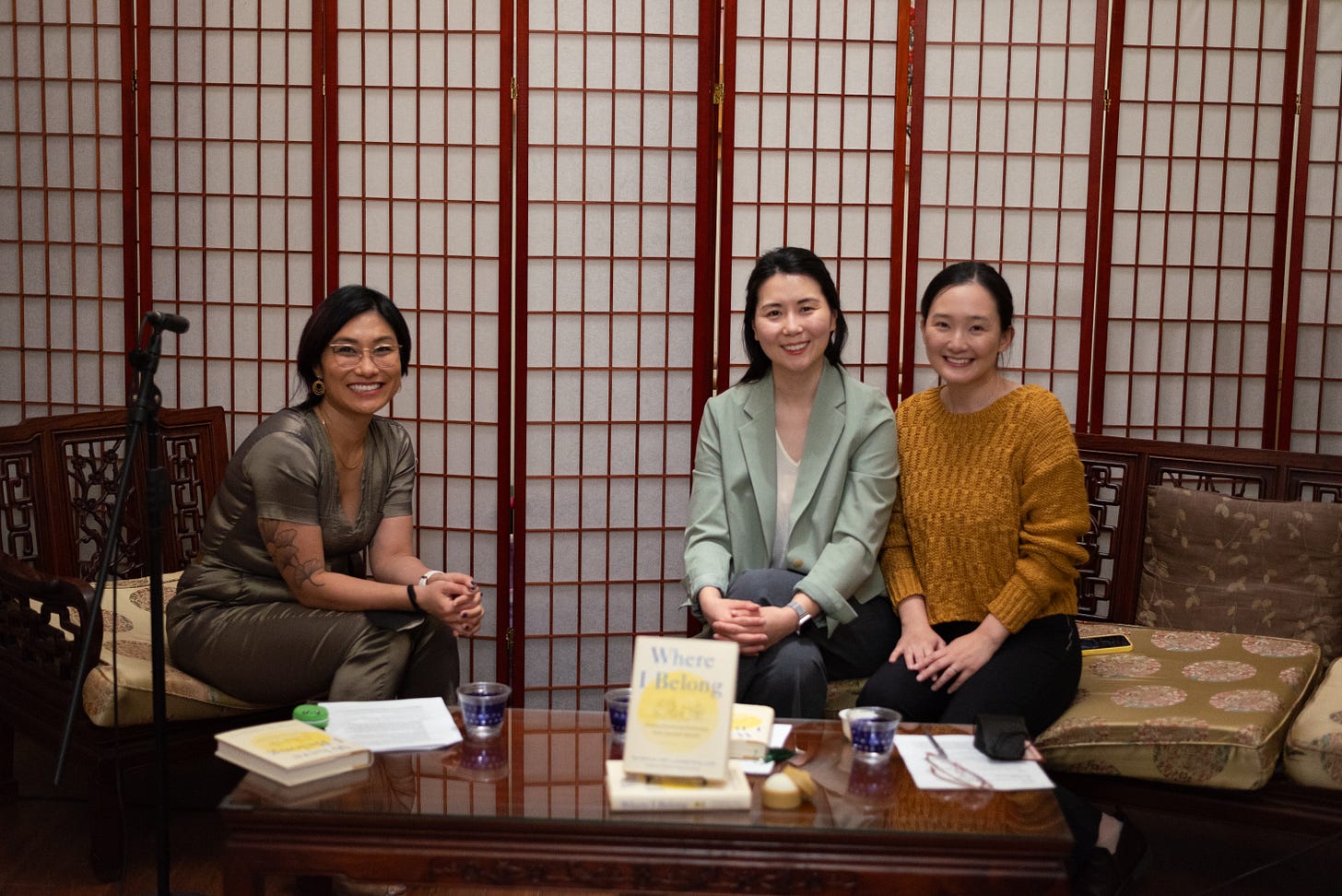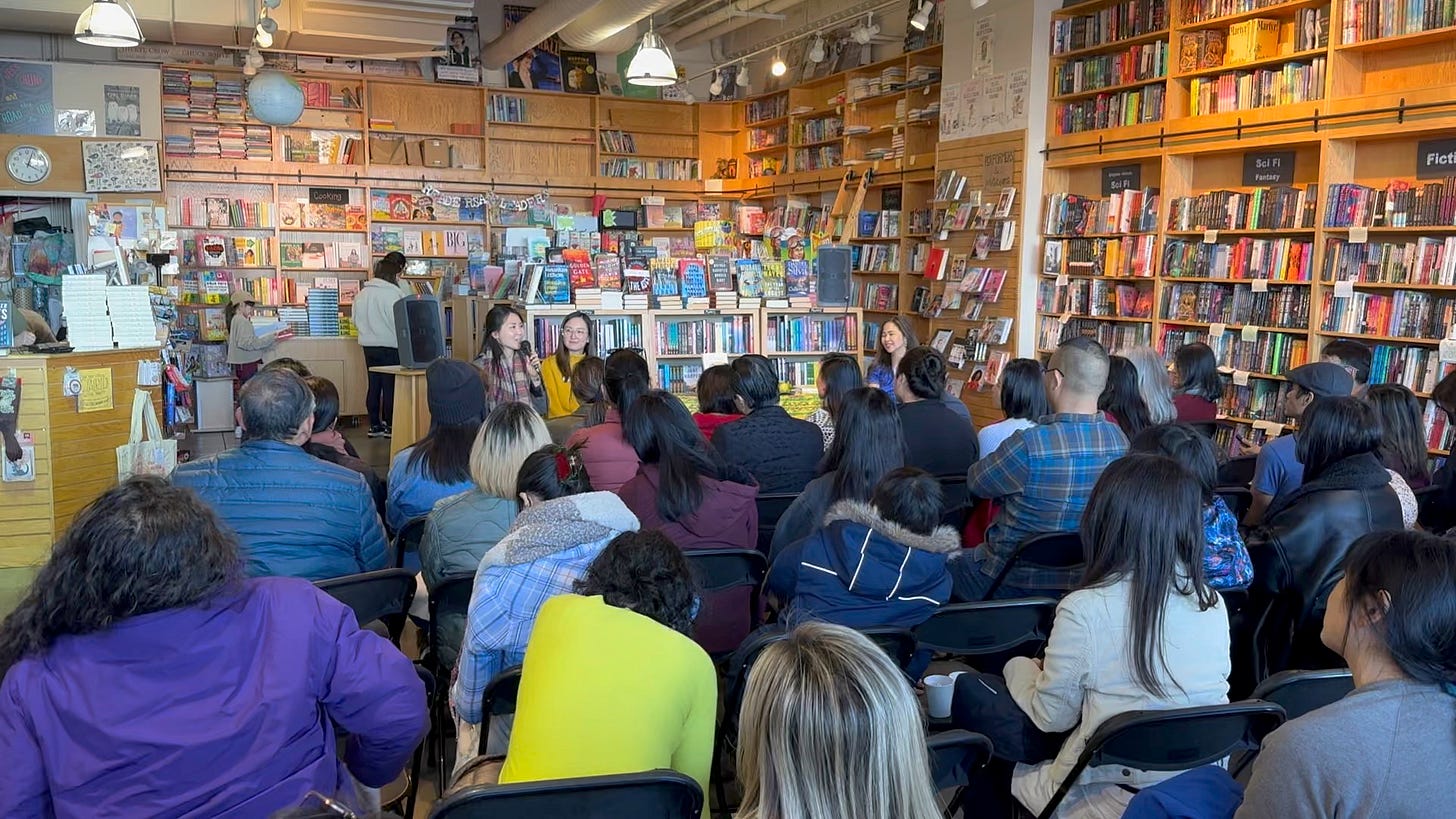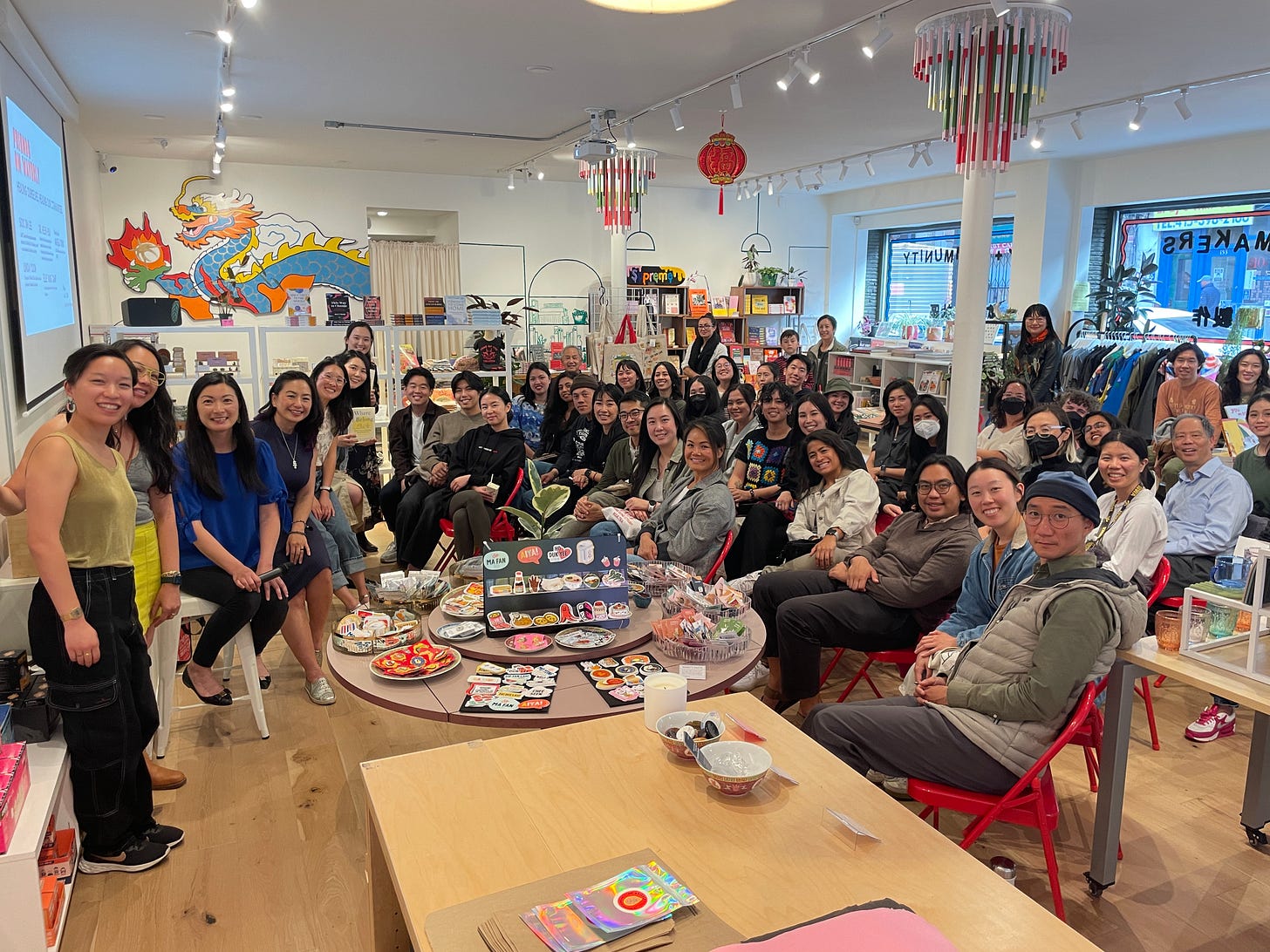healing yourself by healing community with soo jin lee and linda yoon
How Linda Yoon and Soo Jin Lee created the resource (and healing), they needed for each other and their younger selves in co-authoring "Where I Belong"
Linda Yoon and Soo Jin Lee met while working in community mental health, serving refugees and immigrants from Southeast and East Asia. And as they worked with these communities, they found that the individual talk therapy model they had been taught didn't work for communities with tremendous amounts of individual and collective trauma.
Many community members didn't know why they were there—they were just told to show up. The system required them to see a therapist in order to see a psychiatrist who could prescribe them the medication they needed. With linguistic and cultural barriers and stigma around the idea of coming to a therapist or psychiatrist, Linda and Soo Jin didn't even know where to start.
But they soon found that holiday events and community gatherings allowed for much-needed intergenerational and trauma healing that couldn't be accomplished in individual talk therapy sessions. Through that, they realized that community care and the ability to bring people together would be vital in bringing trauma healing to communities.
Linda later started Yellow Chair Collective, a group practice specializing in serving Asian American and multicultural clients that provides culturally responsive, trauma-informed, and LGBTQIA-affirming counseling and psychotherapy services, which Soo Jin later joined as partner and Executive Director.
Then the pandemic hit, and Linda and Soo Jin started virtual community support groups that became the foundation and lead-up to their co-authored book on trauma, healing, and mental health in Asian and Asian American communities.
Soo Jin Lee and Linda Yoon are professional therapists who witnessed firsthand how mental health issues often went unaddressed not only in their own immigrant families but in Asian and Asian American communities and did something about it—through their work at Yellow Chair Collective, their nonprofit Entwine Community and their coauthored book, "Where I Belong."
Catch a post-film Q&A with Yellow Chair Collective’s Linda Yoon and Soo Jin Lee following a free screening DEALING WITH DAD as part of Legendary Makers Market on Saturday, July 27, 2024 at 7:00 pm in Portland, Oregon.
What led you to write "Where I Belong"?
SOO JIN: We were approached by a literary agent who had seen our work leading support groups. Initially, we were just gathering people who needed a space to process what was happening. There was so much anti-Asian hate and people were having a lot of emotional reactions to what was happening. They didn't know where to put those emotions or how to even react to them, so we started creating these groups to help them process.
As we created more groups and those groups became more popular, we started to realize that there was a component missing: education. What was missing was the historical context that this was nothing new. Asian hate has always existed in the history of America. And what does that mean for us? Racism has always existed.
We recognized the importance of contextualizing these things and building an understanding of what trauma looks like in our important educational components. So, we started to build out these closed groups with specific topics of discussion, and from week to week, we built a curriculum that we would post online.
So the literary agent suggested that the work we were already doing would be great to turn into a book—one that could go more in-depth while still bringing an experience of feeling like the reader was sitting in these community groups. That's why, alongside these personal stories, there are educational components, grounding exercises, and journaling exercises for people to reflect on.
Have you done or created anything like this before?
LINDA: No. There was a lot of imposter syndrome and insecurity when it came to writing. We really wanted to create a resource to learn more about Asian American identity, mental health and trauma healing, but we hadn't really written outside of an academic setting for the general public. So, initially, we felt like this was really big and overwhelming. We struggled with perfectionism too. We would write things, delete, and start all over again.
SOOJIN: It was difficult for both of us, professionally and personally. On a professional level, we kept going back and forth on how to make such heavy subject matter about trauma healing accessible to the public—what kind of language to use because we're so used to a clinical way of speaking. And how do we present trauma healing in a way that makes sense to the public?
We had to rewrite over and over again and check in with people who didn't work in mental health, like our spouses or friends. They could read what we wrote and give us feedback on what we were trying to say.
On a personal level, Linda and I both identify as 1.5 generation immigrants—we both came to the US at around 10 years old and had to learn English as a second language. So we have this underlying trauma of how long it took for us to learn English and some of the horrible comments English teachers made to us. And so it was really interesting that as we were writing about identity and trauma, we were having to go through and bring up our own traumas as well.
LINDA: It definitely was a parallel process. We wanted to create something we wished our younger selves had access to as a resource. As we wrote the book, we were also visiting our trauma stories again. There were tears, processing of our traumas, and gaining new narratives as we wrote.
We hope this book brings healing to people in the way it brought healing to us. It's similar to the work we do when working with clients close to our identity, background and experiences. These parallel experiences allow us to understand and relate to one another through the healing process, where, as we're guiding people through their healing, we are also healing ourselves along the way.
How did you move past the perfectionism, imposter syndrome, and all these pressures you were putting on yourself to write this book?
LINDA: We really wanted to create a comprehensive resource that didn't exist, something we knew that we could do given the experience and knowledge we had. And after the book was sold, we had a contract. We had deadlines. That really helped with my ADHD brain to get things done.
SOO JIN: We were locked in then. So it was just like, "well, we gotta do it.” When you read the contract, it becomes so real—so tangible. It's like, "I have to do this now. I have to commit to it."
Linda and I talked about releasing a book one day—it was something we had discussed way before we were approached to write the book, but we just thought it was going to be later. Way later. Like maybe after we retired, we'd write a book together. So when the opportunity came, although it surprised us, the thought of writing the book wasn't exactly a new idea. We just had it on the back burner for later down the line.
LINDA: And, we just had to do it, right? We had to overcome a lot of feelings and self-doubt to feel confident enough to write these books. We do training and workshops and manage and supervise staff, all of which are much easier than writing a book and putting ourselves and our work out there to be judged.
But what really helped me was really grounding myself in why this book mattered and why we were writing it—going back to our "why." And I could just visualize myself giving it to my younger self, who was trying to find words for the experiences I was having—I didn't have any words to understand mental health, especially in terms of my family or Asian American community at the time. And I just imagined sharing all that knowledge Soo Jin and I had gathered over the last 10 years into this book.
It's funny how sometimes life happens like that where you're like, "Maybe someday," and the universe is like, "No, it's happening today," and you're like, "Wait, I wasn't ready!"
SOO JIN: Exactly. Like Linda said, our biggest driver was that we needed a resource like this. When we were doing these groups, many people came to us saying they knew someone who could use this information, but they weren't ready to come to a space like this yet. We hear this with our individual therapy clients, too.
So the question became how we could support them and bring this information to them, and we had nothing—nowhere to send them other than maybe a few articles here and there. We knew this book needed to exist.
So, where did you start when writing a book like this—when nothing existed like this before?
LINDA: We used social media and newsletters to let people know about the book and put out an open call for people to share their stories. As we got these first-person accounts, they gave us some cues on details to add or directions to explore in each chapter.
We also reached out to people we personally knew in our community who could be a good addition. What's unique about our book is that we found the cues and directions based on the stories we included inside. We wanted "Where I Belong" to be led by community stories rather than us dictating the direction.
SOO JIN: With Linda and I being two authors, there was a lot of navigating the organization because of all the different elements of the book. We had a working guide and knew which subject matter we wanted to address and which educational portions we really wanted to include in the book. We would lay those guides out and each took a lead on certain elements. After we conducted all the interviews, we compiled the stories and tried to determine which chapter they would best fit.
Even though you had a unique experience of being approached to write the book rather than having to pitch your book idea, did you face any pushback or skepticism with the format or idea of the book as you were writing it?
SOO JIN: Definitely. We were very lucky to be approached and have an agent from the get-go as we dove into the publishing world. But when we met with potential editors in different publishing houses, some editors said, "Nobody wants to read a textbook." And that's not what we were trying to do—that wasn't the purpose of this book.
We also noticed that in some of the meetings, there would be an Asian American employee who had nothing to do with the project itself. That also gave us an idea of who we didn't want to work with because they clearly didn't understand what we were trying to communicate to the world.
Even after the book was published, we have had different bookstores tell us that it was too niche or that there weren't enough Asian Americans in their city or town to host a book talk on topics like identity and mental health.
When you first started your book tour, you shared that you had just finished a pretty significant milestone for the book—you had just selected the voice actors for the audiobook. Can you talk a bit about that?
SOO JIN: Yes! It's actually a very funny story. At the time, we didn't think you had to audition for your own audiobook. We thought it was a given that the author gets to read their own book—especially when it's nonfiction.
Our agent, our editor and even the publishing house told us that, as authors, we were more likely to be accepted to read for the audiobook since we knew what we were going to say. So I told Linda that I was interested in reading the book.
Part of me wanted to read the book because I thought hearing my own voice would empower me and help me overcome the trauma of English being my second language. I really thought it was going to be this sort of ultimate, empowering, overcoming-of-trauma moment for me.
So I started practicing reading the book at home—I would record it and reread it and record it and reread it—and as I was doing this, instead of feeling more empowered, I felt the opposite.
What I didn’t know about the process is that you go into the recording studio and read the book for six to eight hours a day until it's finished—and as I was practicing, I was already tired after 30 minutes! I was physically drained, and my voice was going out, and I was like, yeah, this is probably why they have voice actors do this.
But I ended up sending the recording anyway, and they gently and encouragingly told us they could find a good, fitting voice actor to read the book.
I quickly gave up that dream, but writing the book itself was already a huge accomplishment, so I'll take it.
Catch a special presentation of DEALING WITH DAD, followed by a Q&A with the filmmaker Tom Huang as well as the Yellow Chair Collective’s Linda Yoon and Soo Jin Lee as part of Legendary Makers Market on Saturday, July 27, 2024 at The Patricia Reser Center for the Arts (“The Reser”) in Beaverton, Oregon.
For more about the “Where I Belong,” click here.









So much respect for Soo Jin and Linda and the work they are doing. Thank you for this terrific interview!
Fantastic interview with Linda Yoon and Soo Jin Lee, wonderful to learn more about the community-driven work that they do and their book, "Where I Belong."